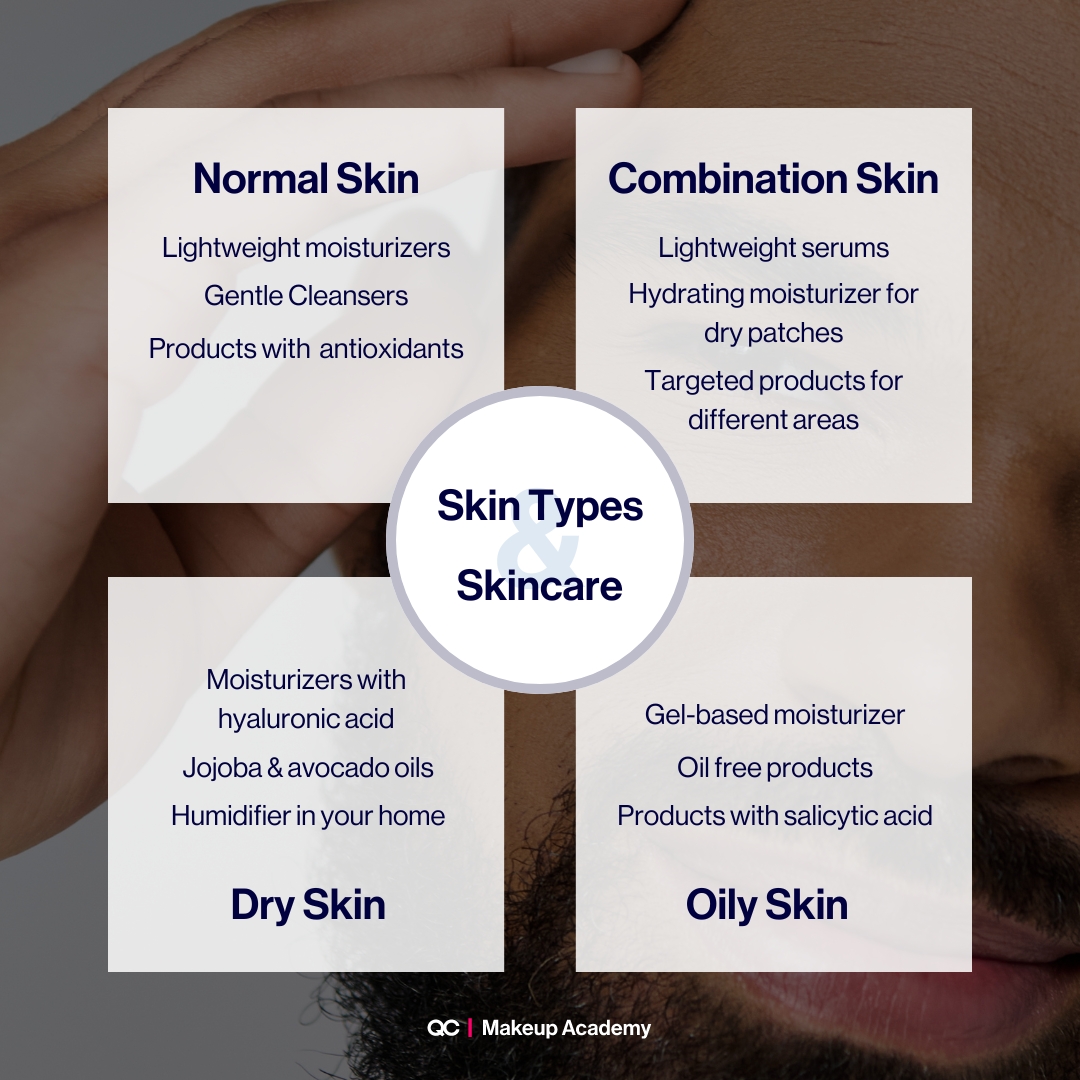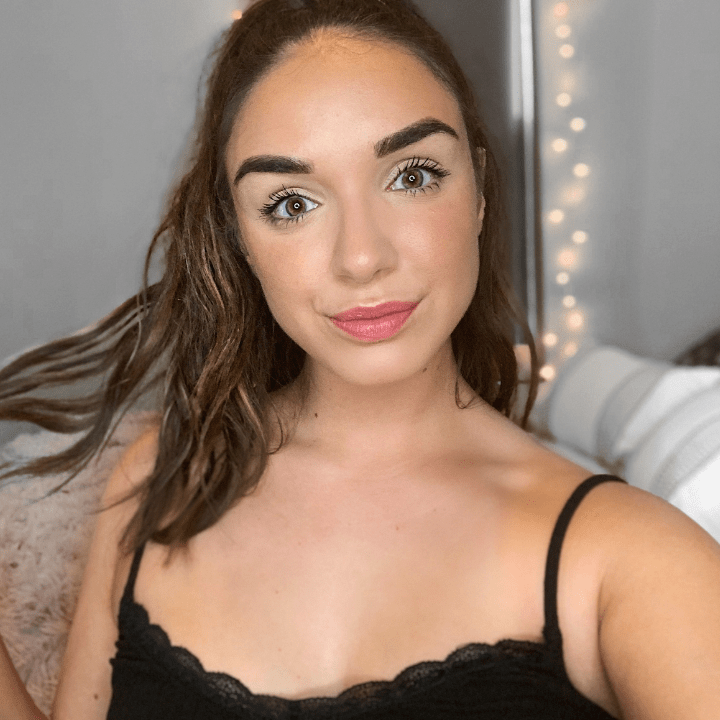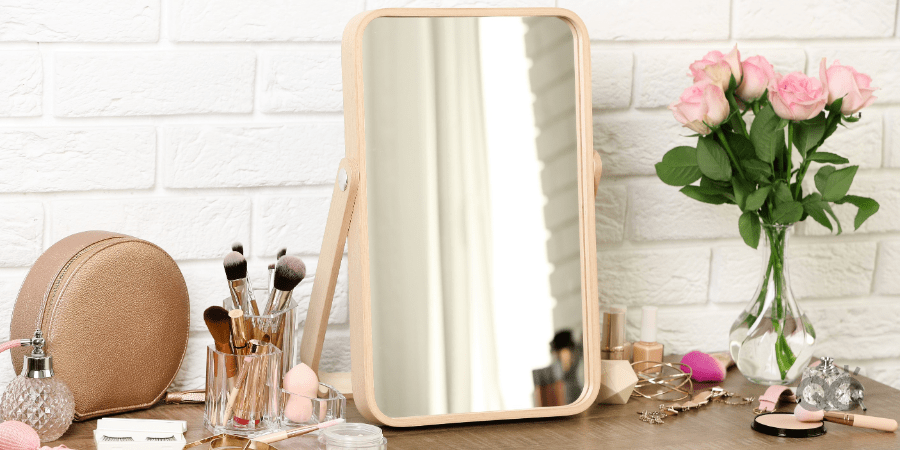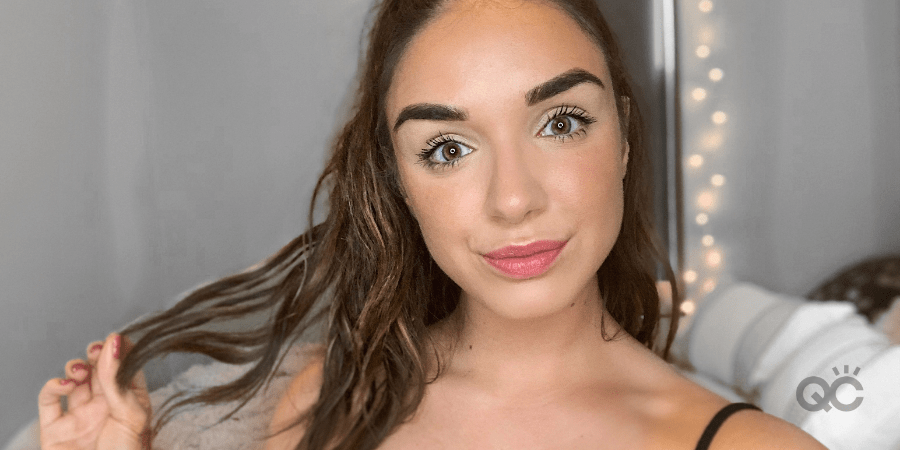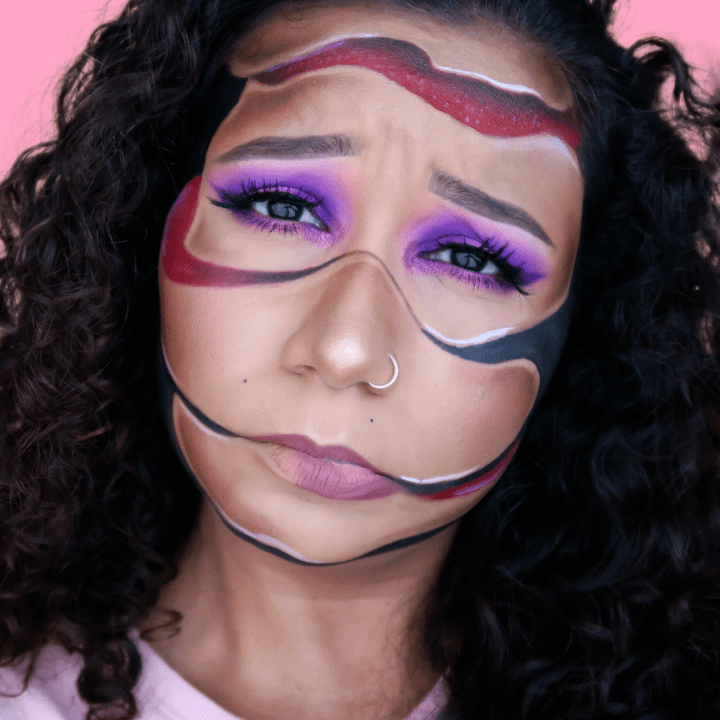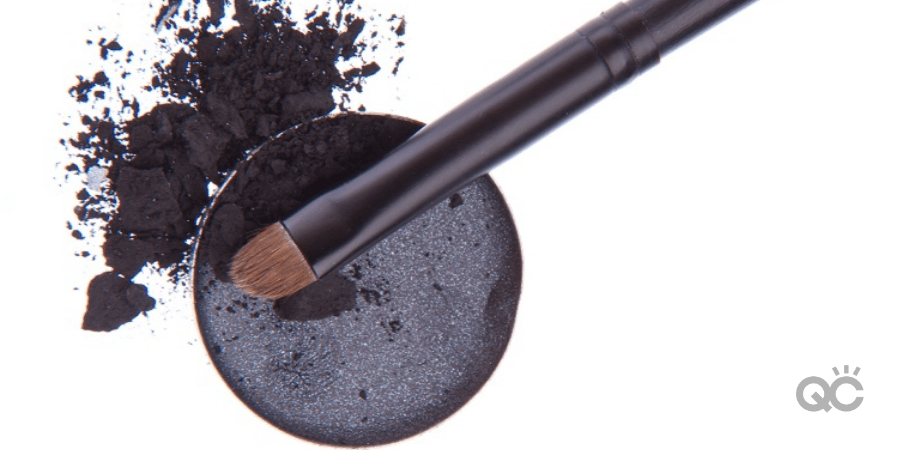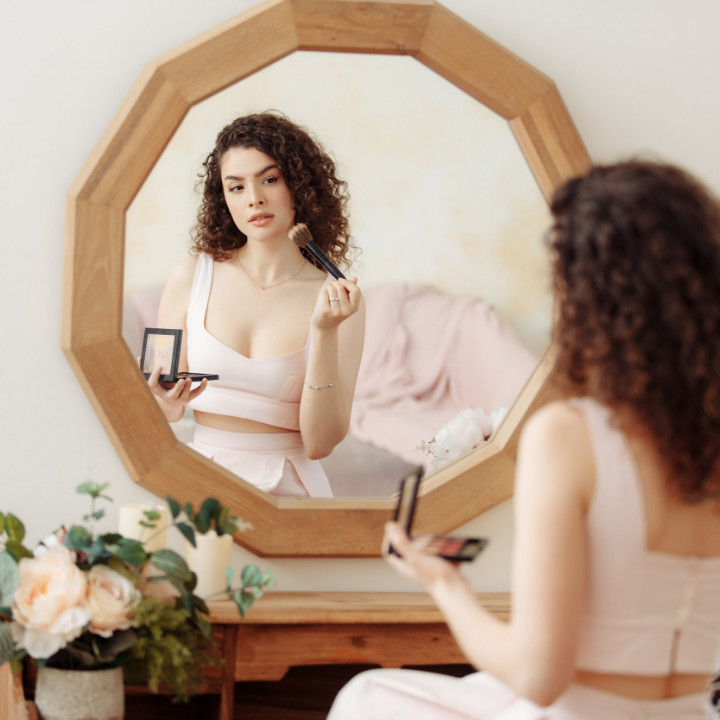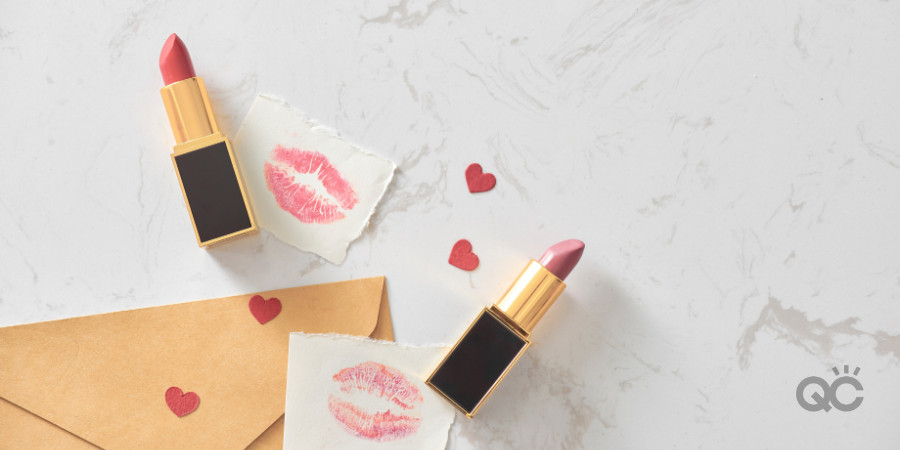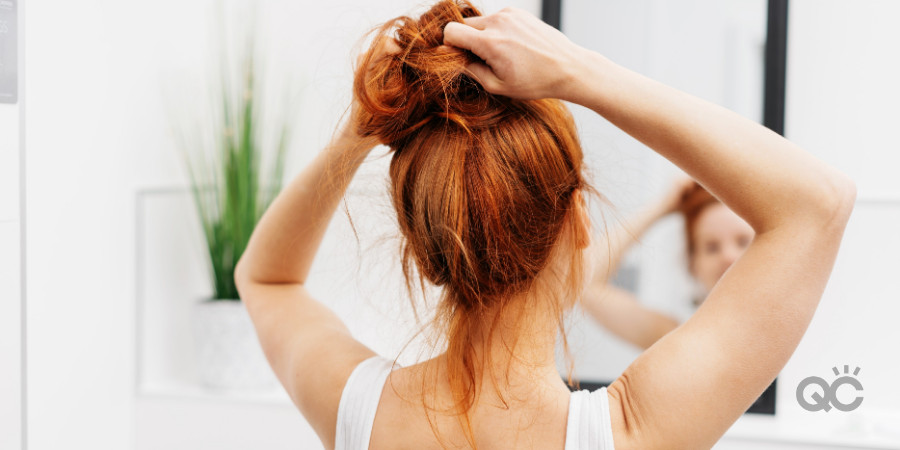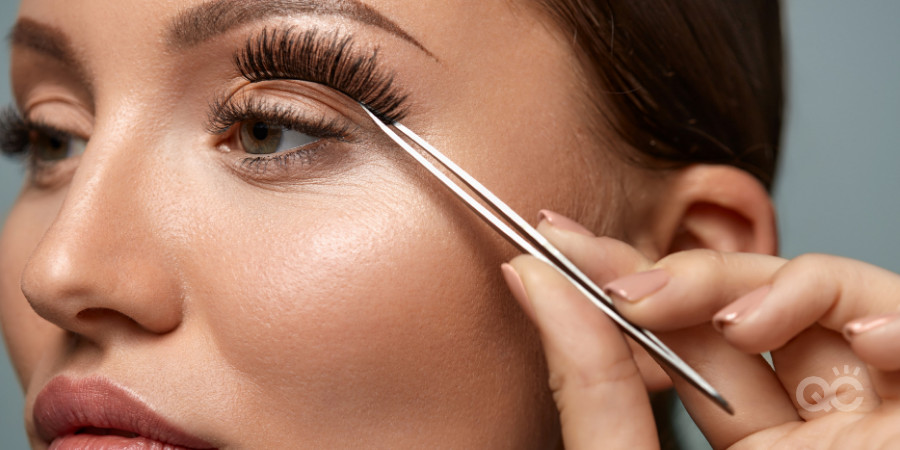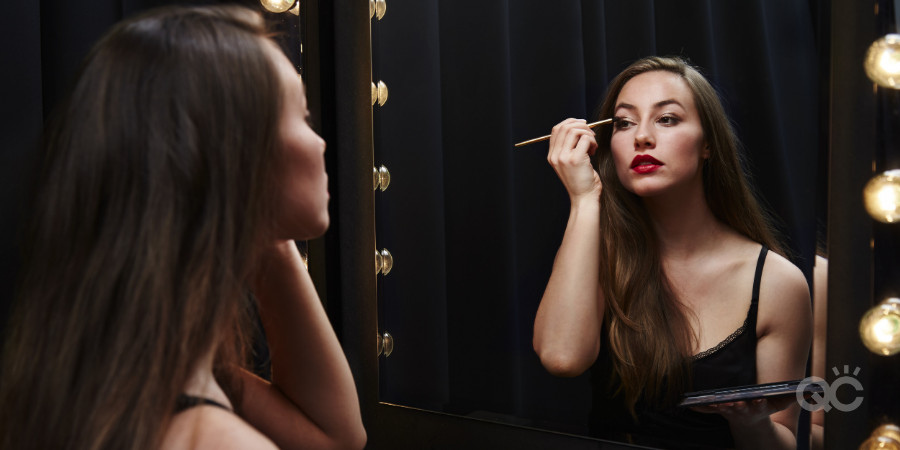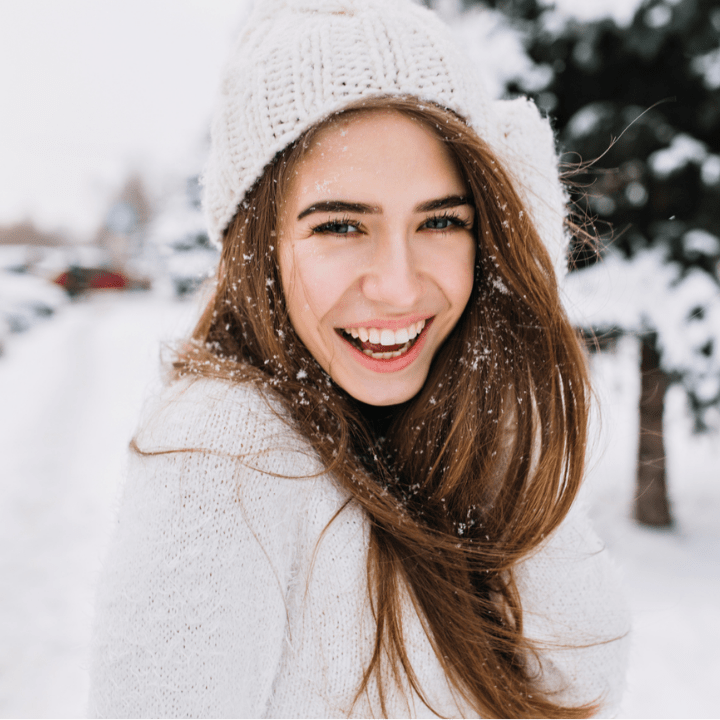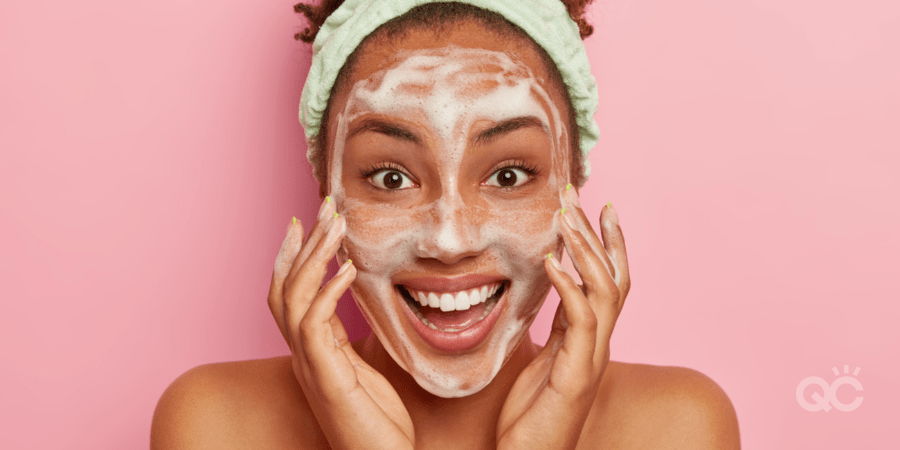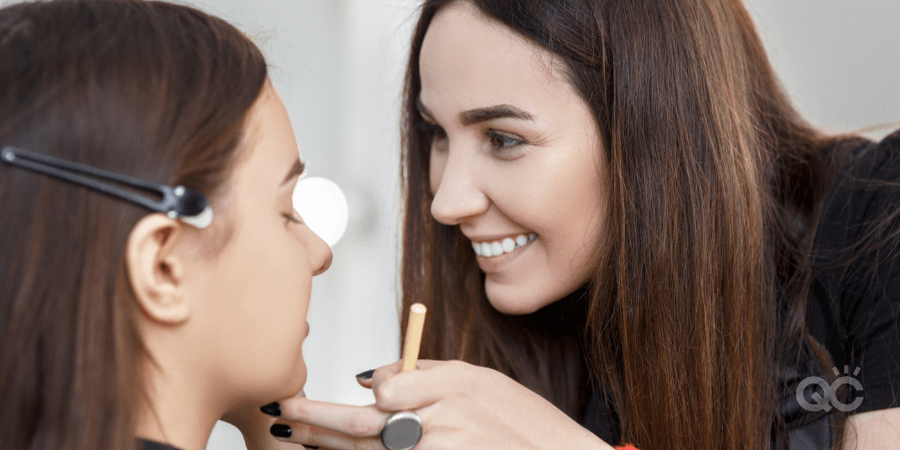
Key Points
- The 3 main somatotypes are ectomorph (lean), mesomorph (muscular), and endomorph (curvy).
- Stylists also use five visual body shapes: rectangle, triangle, inverted triangle, hourglass, and oval.
- Understanding fit, fabric weight, and drape helps clothes flatter every body type naturally.
- The Kibbe system blends body structure and personality to create individual style identities.
- Modern styling is inclusive and body-positive, celebrating every size, age, and gender identity
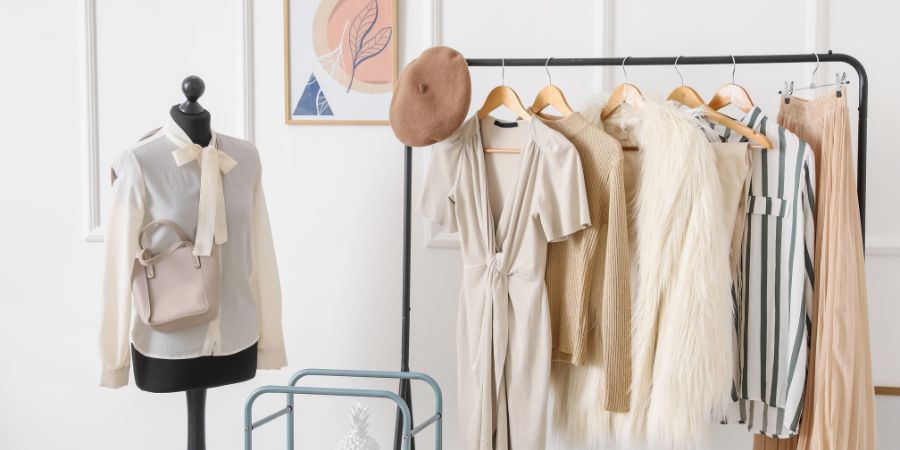
Introduction
Every client’s body is unique. For a personal stylist, understanding and classifying body types is key to helping each person look and feel their best. This skill blends science and art, combining somatotypes (how muscle, fat, and bone are distributed) with visual body shapes like the hourglass or rectangle. It’s not about size or perfection, but about balance and confidence!
So, keep reading to discover how understanding body types will elevate both your styling skills and your career!
The Science Behind Body Types (Somatotypes Explained)
In the 1940s, psychologist Dr. William Sheldon introduced the concept of somatotypes: three main body types describing how the body naturally distributes muscle and fat:
- Ectomorph – Slim, long-limbed, and delicate. Often needs structure or layering to add volume.
- Mesomorph – Naturally balanced and athletic with visible muscle tone. Looks great in tailored fits and clean lines.
- Endomorph – Softer and curvier, with a fuller midsection or hips. Flows best in fabrics that move and elongate.
Most people fall somewhere in between. For instance, an “ecto-mesomorph” might combine length and tone. As a personal stylist, understanding these core body types helps you predict how fabric, cut, and silhouette will drape.
It’s the very foundation for translating anatomy into fashion!

From Anatomy to Aesthetics: Translating Body Types into Style
Understanding the science of body types is only half the story, though. The real art of styling comes from translating anatomy into visual balance and proportion. This means using your knowledge of somatotypes to understand how clothing interacts with a client’s natural body shape—not to change it, but to enhance it.
After all, every outfit tells a story, and as a stylist, you’re the storyteller. When you know how to choose cuts, fabrics, and proportions that work with a client’s body, you can transform how they see themselves.
How Somatotypes Influence Fit and Style
Each body type interacts with fabric differently. Knowing this helps you select materials and silhouettes that flatter naturally:
Ectomorphs
- Naturally lean, so structured or layered outfits help add definition.
- Opt for thicker fabrics (like tweed or denim) and layering to add visual volume.
- Rounded necklines, wider sleeves, or peplum details help soften sharper lines.
Mesomorphs
- Balanced builds look best in clean, fitted lines that maintain symmetry.
- Medium-weight fabrics like cotton, knits, or linen work beautifully.
- Tailored blazers or wrap-style tops highlight the waist without over-emphasizing it.
Endomorphs
- Softer shapes look stunning with fluid fabrics that follow the body’s curves.
- Draped or gathered styles (like wrap dresses or bias-cut skirts) flatter natural lines.
- Vertical stripes or monochrome outfits elongate the frame while keeping movement elegant.
When you understand these relationships, you’re not guessing what looks good. Instead, you’re creating visual harmony between fabric and form!
The Power of Fabric, Weight, and Drape
Fabric choice changes everything. Think about it: the exact same dress can look completely different depending on the weight and drape of the material. Lightweight fabrics skim the body, whereas heavy ones sculpt it.
The trick is balance! So, here’s what we recommend:
- Use light fabrics (silk, chiffon) for softness and flow.
- Choose medium weights (cotton, linen) for everyday versatility.
- Add structure (wool, denim) where you want strength or shape.
Touch and test fabrics often. A stylist’s hands should know how materials move before they reach a client’s closet.
Balance Over Perfection
Now, one of the biggest myths about styling is that it’s about “fixing” what’s wrong with the body. However, that couldn’t be more incorrect! As we said, styling is about balance.
- Wide shoulders? Add fullness at the hips to create symmetry!
- Fuller hips? Emphasize the upper body to even proportions!
- Straight figure? Use layers or belts to define curves!
When stylists focus on proportion instead of size, clients feel confident instead of self-conscious. The magic happens when they realize their body doesn’t need to change—merely the way they style it.
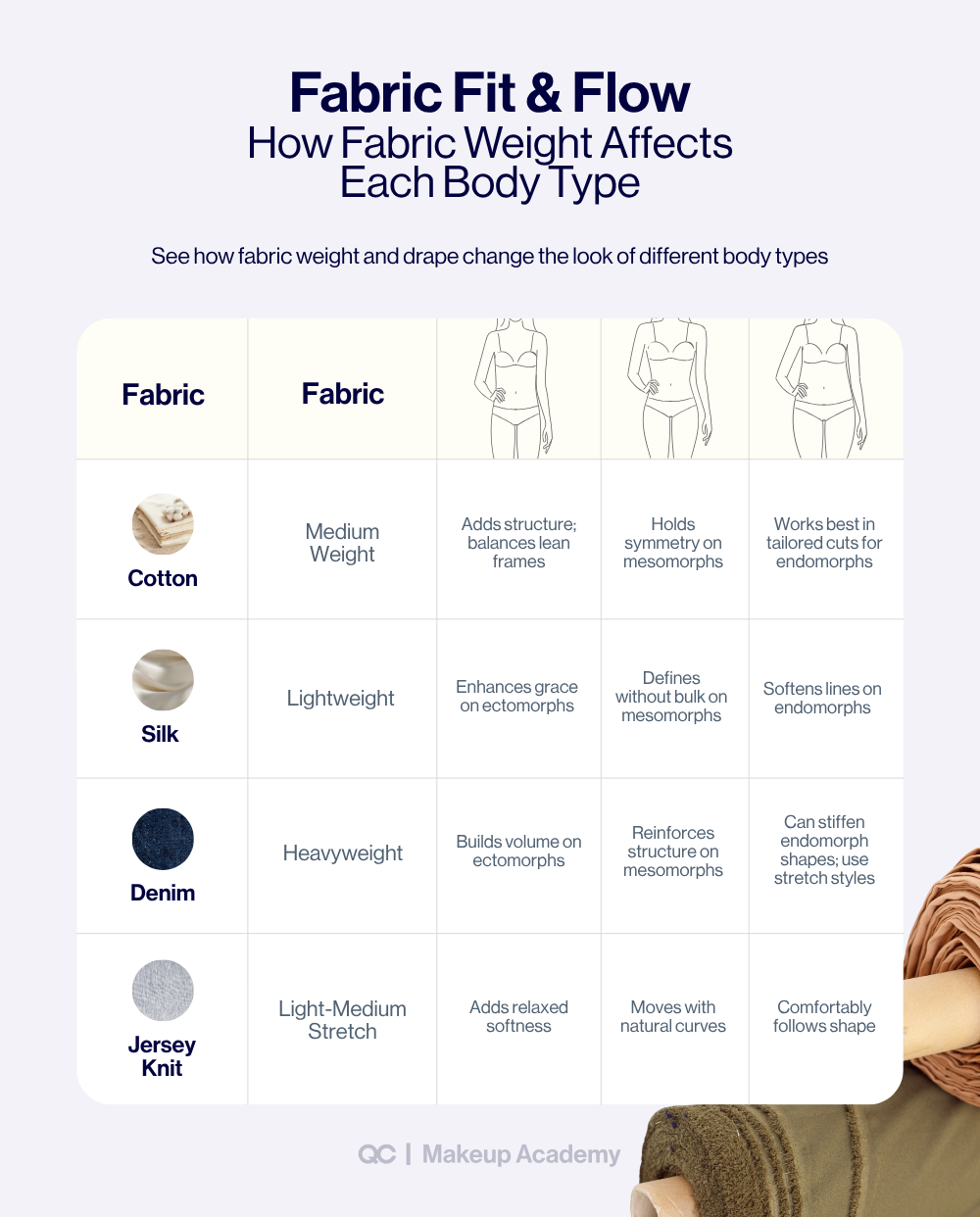
Beyond the Basics: The Fashion Body Shape System
Now that you understand somatotypes, the next step is learning about body shapes: the visual proportions that define how clothing fits and flatters the body.
While somatotypes describe structure and composition, body shapes focus on appearance and proportion. Meaning, how the shoulders, waist, and hips align. For personal stylists, this system bridges science and art. As a result, you can then guide clients toward cuts and silhouettes that feel balanced and natural.
Body shapes aren’t about gender or size (we’ll delve deeper into this in a bit!). They’re simply tools for understanding proportion, something everyone has. The goal is to create harmony, not to fit a label.
The Five Main Body Shapes
Most people fall into one or a blend of these common body shapes:
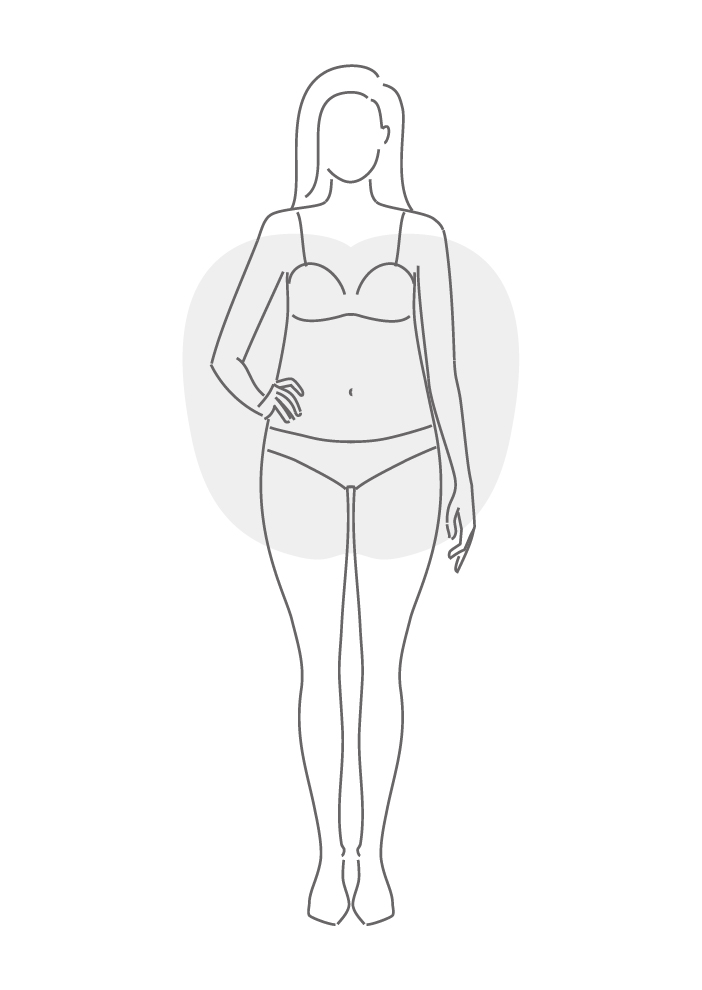
Oval (Apple Shape)
Fuller through the midsection with narrower shoulders and hips. Flowy tops, empire waists, and open jackets elongate the torso, while shorter hemlines highlight great legs.
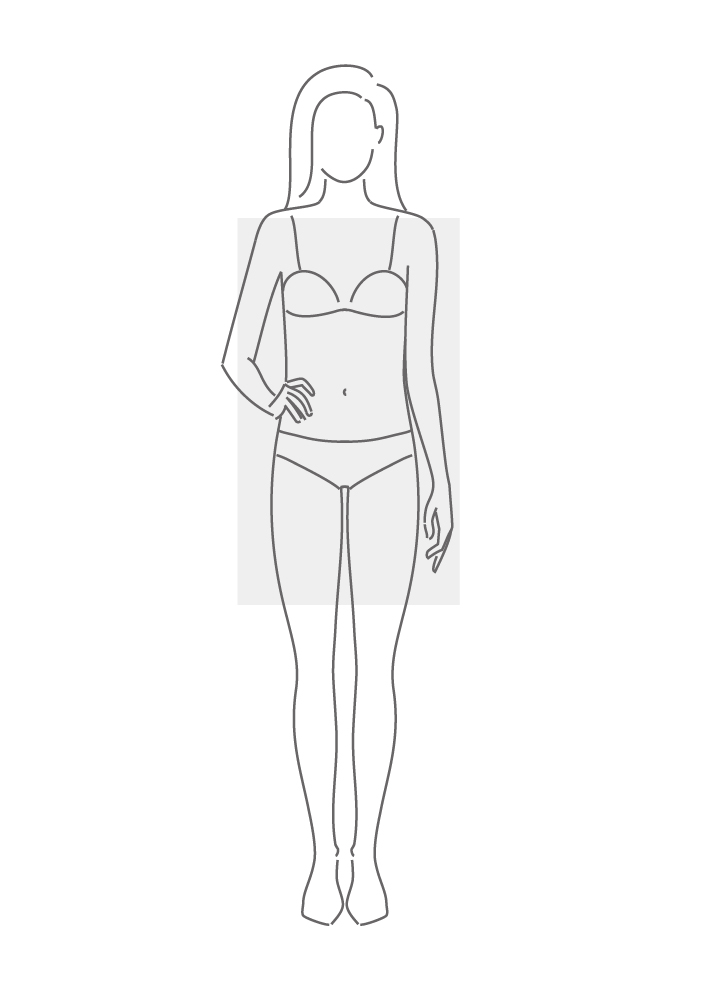
Rectangle (Straight Shape)
The shoulders, waist, and hips are about the same width, creating a balanced, athletic look. To add shape, use belts, wrap styles, or layered textures. Structured jackets or peplum tops can define the waist and add visual dimension.
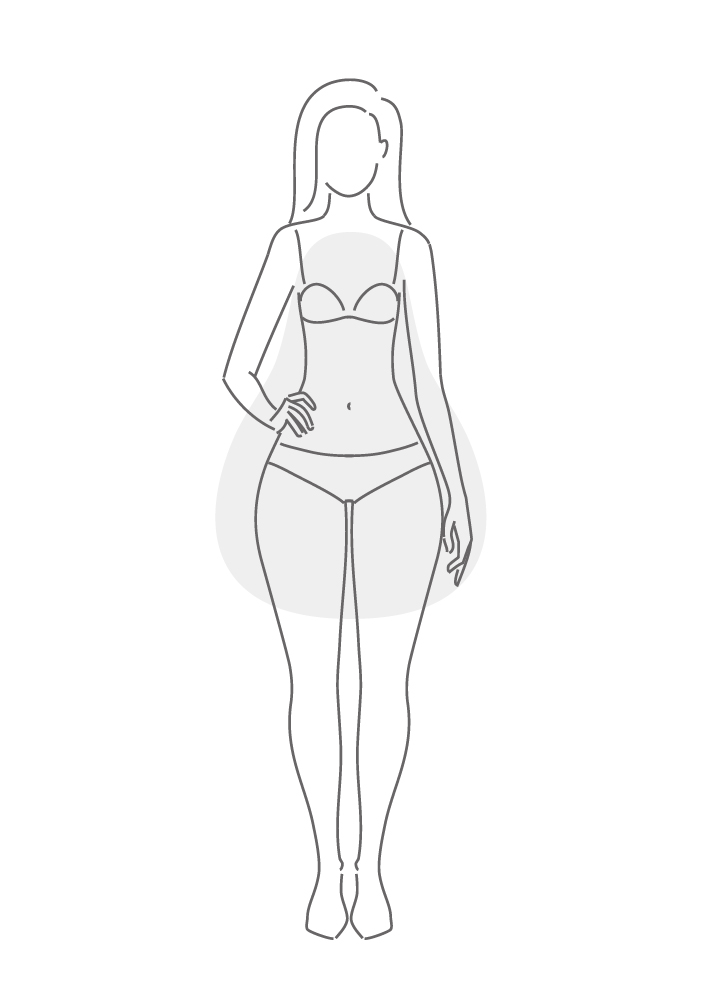
Triangle (Pear Shape)
The hips are wider than the shoulders, often with a smaller upper body and defined waist. Draw the eye upward with light colors, shoulder details, or statement accessories. A-line skirts and straight pants help elongate the lower half.
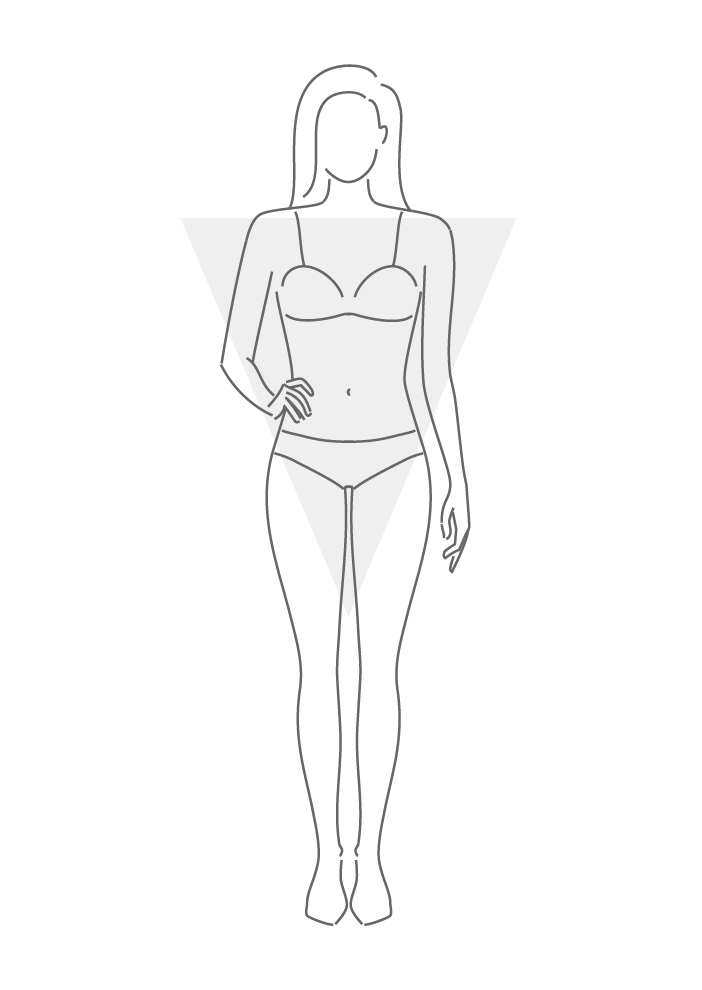
Inverted Triangle
This shape features broader shoulders and a narrower lower body. Balance the frame with wide-leg trousers or A-line skirts, and choose V-necklines or wrap tops to soften the upper half.

Hourglass
The shoulders and hips are similar in width, with a defined waist and curvy proportions. Emphasize the waist with fitted garments or wrap styles, and opt for fabrics that drape instead of cling.
Why Body Shapes Matter in Personal Styling
Knowing how to identify and style body shapes gives you a practical framework for personal styling. This is because it helps you visualize where to add structure, softness, or movement to create balance—no matter the client’s age, size, or identity.
Stylists who master this skill don’t focus on hiding or fixing anything. Rather, they use proportion to highlight confidence. Every client deserves clothes that celebrate their natural shape.
How to Identify a Client’s Body Type (The Stylist’s Process In 4 Steps)
One of a stylist’s most valuable skills is learning how to identify body types accurately and respectfully. This process is about observation, not judgment; noticing proportion, line, and movement so you can recommend styles that feel comfortable and confident.
Step 1: Observation
Have your client stand naturally in front of a mirror wearing fitted, non-restrictive clothing. Observe the overall outline of their body; how the shoulders, waist, and hips relate to one another.
Ask yourself:
- Are the shoulders or hips the widest point?
- Is the waist defined or straight?
- Does the torso appear long or short compared to the legs?
Step 2: Measurements
Confirm your visual observations with four quick measurements:
- Shoulders – Across the back, edge to edge.
- Bust or Chest – Around the fullest part.
- Waist – At the narrowest point of the torso.
- Hips – Around the fullest part of the hips and seat.
Comparing these numbers helps identify body shape patterns:
- Shoulders and hips equal → Hourglass or Rectangle
- Hips wider than shoulders → Triangle
- Shoulders wider than hips → Inverted Triangle
- Waist close to bust/hips → Oval
These measurements aren’t about size; they reveal proportion, a.k.a. the foundation of good styling.
Step 3: Evaluate Proportion and Fit
Think of the body in thirds: upper body, waistline, and lower body. From there, use this as a visual map for balancing outfits. For example:
- Longer legs? Try cropped jackets or high-waisted pants.
- Longer torso? Try layered tops or mid-rise trousers.
- Broad shoulders? Opt for V-necks or soft draping.
The goal is harmony. You always want every piece of clothing to complement the body’s natural rhythm.
Step 4: Confirm with The Fit Test
Obviously, though, even the best-measured outfit can fail the real-world test if it doesn’t move with the client. We highly recommend using QC’s “Garment Movement Test” from the Personal Styling Course to confirm proper fit:
Ask your client to:
- Kneel and stand up.
- Bend to touch their feet.
- Lift their arms overhead.
- Sit, cross, and uncross their legs.
- Walk naturally for several steps.
If the garment rides up, tugs, or gaps, the fit isn’t quite right—even if the size number says otherwise. Proper fit should feel comfortable, balanced, and effortless.
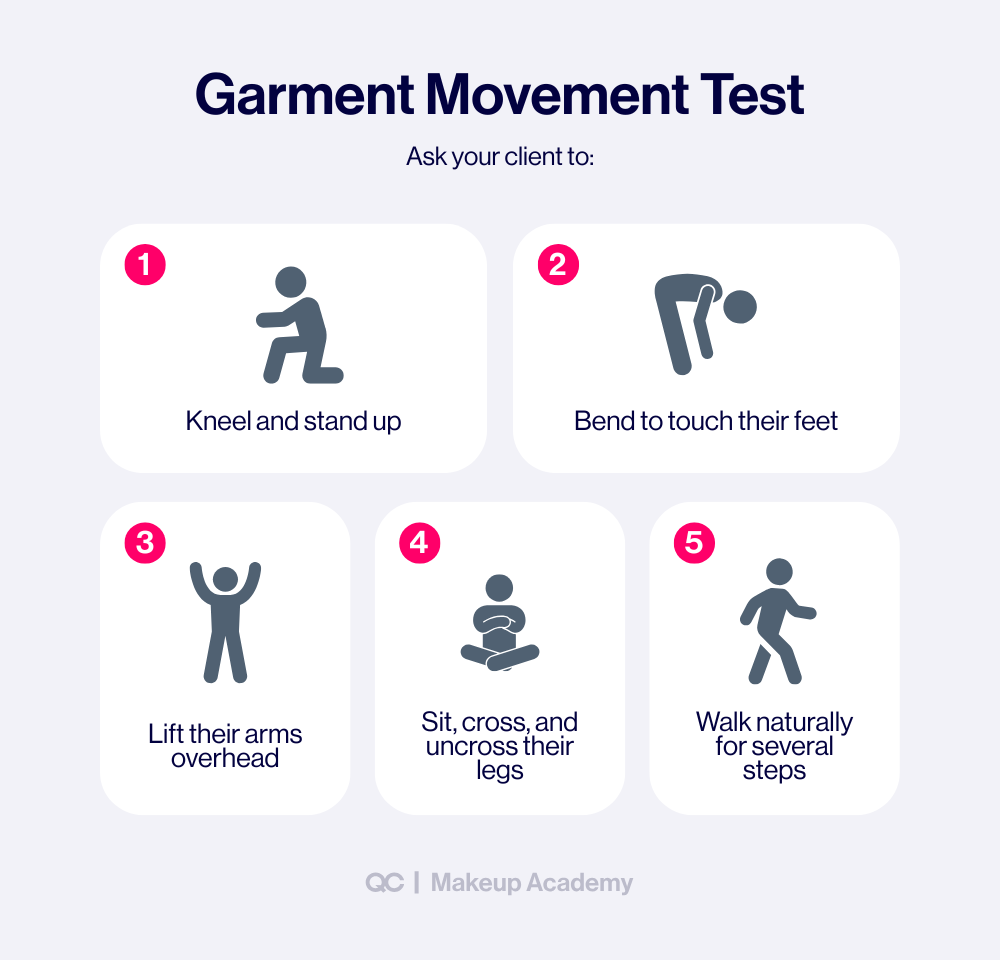
Styling Strategies by Body Type
As we’ve discussed, every body has its own natural lines, curves, and structure. Your goal as a stylist is to use fabric, proportion, and silhouette to enhance those natural strengths.
Ectomorph
Earlier, we mentioned how ectomorphs are naturally lean with long limbs and delicate bone structure. Thus, their shape looks best with styles that add structure and softness.
Styling focus: Add volume and definition.
- Choose thicker or textured fabrics like tweed, denim, or wool.
- Use layering, gathered details, or belted waists to shape the frame.
- Rounded necklines and wide sleeves add balance.
- Avoid clingy or ultra-thin fabrics that hang too loosely.
Ectomorphs wear modern, tailored shapes beautifully. Think fitted blazers, cuffed pants, or structured coats that give the body presence.
Mesomorph
Mesomorphs have an athletic, naturally proportional frame with defined shoulders and waist. This makes them one of the most versatile types of muscular bodies to style!
Styling focus: Highlight structure and symmetry.
- Choose medium-weight fabrics with gentle drape — cotton blends, linen, or crepe.
- Fitted blazers, wrap tops, and straight-leg pants accentuate balance.
- Keep cuts clean and tailored to show off proportion.
- Avoid overly boxy or tight pieces that hide the waist or restrict movement.
Mesomorphs shine in outfits that feel both sleek and effortless; structured but never stiff.
Endomorph
Endomorphs have softer, fuller builds with natural curves. Importantly, the goal here is not to minimize. Instead, you want to move with their shape.
Styling focus: Enhance curves through flow and balance.
- Choose draped fabrics like jersey, viscose, or silk that follow the body’s lines.
- Try wrap styles, empire waists, or monochrome outfits for smooth vertical flow.
- Longline blazers or cardigans help elongate the frame.
- Avoid stiff or bulky fabrics that restrict movement.
When styled thoughtfully, endomorph clients look elegant, comfortable, and confident.
Blended Body Types
Styling focus: Balance the dominant features.
As we mentioned earlier, however, most clients you work with are going to be hybrids. For example, an “ecto-mesomorph” (lean with athletic tone) or a “meso-endomorph” (curvy with definition). Therefore, you should use elements from both body types—structure where needed, softness where it flatters—to create a custom look.
At the end of the day, when you can dress all body types with precision, you move from following rules to creating harmony. Great styling is about letting the body speak!

Modern Inclusivity and Gender Diversity in Body Typing
The way we talk about body types is evolving—and that’s essential progress. In the past, body typing systems often used limited, gendered, or idealized language. But today’s personal stylists know that beauty and balance exist across every identity, size, and gender expression.
When classifying body types, it’s important to remember that these systems were created in a time when inclusivity wasn’t part of the conversation. Modern styling moves away from “male” or “female” categories and instead focuses on proportion, drape, and self-expression.
Classifying Body Types Beyond Binary Labels
Bodies don’t fit into boxes, and styling shouldn’t either. Instead of using gendered language, focus on lines, proportion, and balance. Whether a client identifies as male, female, nonbinary, or gender-fluid, the same styling principles apply:
- Observe where the body carries width or length.
- Adjust structure and drape to create harmony.
- Use fabrics and silhouettes that align with comfort and identity.
When you work from proportion instead of gender, every client will feel seen and celebrated!
How Age and Lifestyle Affect Body Type
Understandably, bodies naturally change with time. Age, hormones, and lifestyle all affect how muscle and fat are distributed. Stylists often see these shifts as clients enter new life stages. For instance, a defined waistline may soften, or new curves may appear.
These transitions aren’t challenges to fix. They’re opportunities to restyle!
For instance:
- A client entering midlife may love soft, flexible fabrics that move easily.
- Someone becoming more active might suit structured pieces that show tone.
- Clients recovering from pregnancy or medical changes benefit from adaptable, flowing silhouettes.
Understanding these shifts allows you to keep clients stylish and comfortable through every stage of life.
Creating an Inclusive Experience
Ultimately, inclusivity in personal styling is about creating a space where every client feels safe, respected, and heard. The language you use matters! Replace terms like “problem areas” or “flaws” with neutral phrases such as “balance,” “shape,” or “proportion.”
Ask open, respectful questions like:
- “What parts of your body make you feel most confident?”
- “Are there any styles or fabrics that make you uncomfortable?”
- “How do you want your clothes to make you feel?”
These questions shift the focus from appearance to emotion, which is where personal style truly lives.
As a personal stylist, your empathy is your most powerful tool. When clients trust that your goal is to celebrate their individuality, they’ll see styling not as vanity, but as self-expression and self-care.
The Kibbe Body Type System (For Advanced Stylists)
After you’ve mastered the basics of classifying body types and body shapes, you can take your styling skills further with the Kibbe Body Type System. Developed by image consultant David Kibbe in the 1980s, this approach blends physical traits, personality, and presence to create what he calls a client’s “style identity”.
In a nutshell, the Kibbe method looks beyond size or symmetry. It’s once again about harmony; how someone’s lines, movement, and energy work together to form their unique aesthetic.
The Yin and Yang Principle
At the heart of Kibbe’s system is the concept of yin and yang, symbolizing softness versus structure.
- Yin represents roundness, delicacy, and curves.
- Yang represents sharpness, height, and angularity.
Every person has a balance of these traits. For example, someone tall and angular leans toward yang, while someone softer or curvier expresses yin. Naturally, most people fall somewhere in between. This is what makes styling so individualized.
When you understand this balance, you can match clothing lines to a client’s natural energy and make an outfit feel effortlessly right!
The Five Main Kibbe Families
Kibbe’s 13 body types fall into five main “families,” each blending yin and yang in unique ways:
Dramatic (Sharp Yang)
Tall, elongated, and striking. Looks best in sleek, structured silhouettes and bold lines.
Natural (Soft Yang)
Relaxed, athletic, and broad-shouldered. Suits unstructured, easy styles and organic fabrics.
Classic (Balanced Yin and Yang)
Symmetrical and refined. Shines in timeless, well-fitted garments with clean design.
Gamine (Contrasted Yin and Yang)
Petite with both soft and sharp traits. Pulls off cropped cuts, playful patterns, and youthful looks.
Romantic (Soft Yin)
Rounded, curvy, and delicate. Glows in draped fabrics, flowing dresses, and soft detailing..
Furthermore, each family also includes “subtypes” (like Soft Classic or Flamboyant Natural) for even more precise styling and creative range.
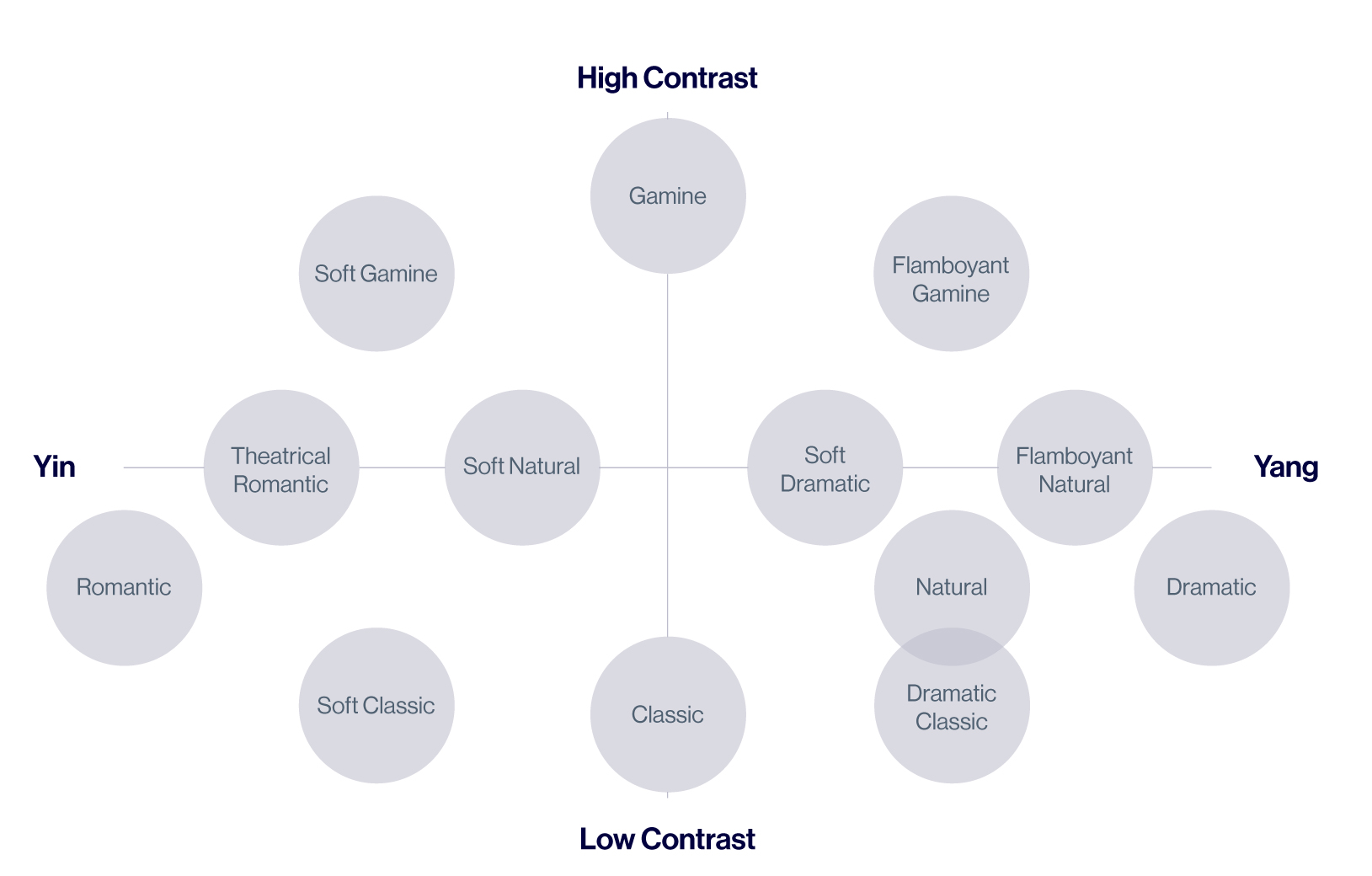
Why Personal Stylists Use the Kibbe System
Kibbe’s framework helps stylists create cohesion between the person and the clothes. Two clients may share the same shape but have completely different energies. One may need sharp tailoring to express confidence, while the other feels most natural in fluid, romantic styles.
What makes Kibbe especially valuable is its body-positive philosophy. It rejects the idea of “fixing” a body and instead encourages stylists to amplify natural features through harmony and design. In short, the Kibbe System isn’t just about identifying body types—it’s about celebrating individuality and using fashion to express authenticity.
The Role of Fit, Weight, and Drape in Flattering Every Body Type
Every great outfit starts with one thing: fit. No matter your client’s body type, the right fit determines whether an outfit looks polished or awkward. As a stylist, understanding how fabric weight and drape affect appearance will help you create looks that flatter naturally, without forcing trends or shapes that don’t work.
In QC Makeup Academy’s Personal Styling certification course, fit, weight, and drape are core styling principles. These concepts allow you to tailor recommendations to each client’s frame, comfort level, and aesthetic goals. Once you master them, you’ll see how small changes in fabric or proportion can completely transform a look!
Fit: The Foundation of Style
A perfect fit enhances shape and movement. A poor fit distracts, no matter how beautiful the clothes are.
Look for these signs of proper fit:
- The garment follows natural body lines without clinging.
- Seams rest comfortably at the shoulders and waist.
- Fabric lays smoothly, without pulling or bunching.
Encourage clients to focus on how clothing feels instead of size labels. Comfort and balance are the true indicators of good fit.
Fabric Weight: Structure vs. Softness
Fabric weight affects how clothing holds shape.
- Light fabrics (silk, chiffon) drape closely and add fluidity.
- Medium fabrics (cotton, knits, linen) offer versatility.
- Heavy fabrics (wool, denim) add structure and strength.
Next, match fabric weight to the body type:
- Ectomorphs: heavier textures add dimension.
- Mesomorphs: medium weights keep natural balance.
- Endomorphs: lighter fabrics move gracefully with curves.
Choosing the right weight brings harmony between fabric and form.
Drape: How Fabric Moves
Stylists use drape to direct the eye. For example:
Drape determines the outfit’s flow and mood. Soft drapes follow the body, while structured ones create power and shape. Combining both adds balance, like pairing a structured blazer with a soft blouse.
- A soft dress enhances curves.
- A crisp jacket adds presence.
- Mixing both creates visual interest.
Proportion: the Rule of Thirds
Stylists often follow the “rule of thirds.” Dividing the body visually into thirds—not halves—creates natural balance.
Examples:
- A cropped jacket (1/3) with high-waisted pants (2/3).
- A midi skirt (2/3) with a tucked blouse (1/3).
This simple concept helps any outfit feel both intentional and flattering, regardless of a person’s body type!
Bringing It All Together
When you combine fit, weight, and drape, styling becomes intuitive. You’ll know when a lightweight fabric needs structure, or when a heavy one needs softness. You’ll also learn how to spot the difference between a flattering fit and a constricting one.
For clients, this knowledge translates to confidence. They’ll move better, feel lighter, and love how their clothes fall naturally. For you as a stylist, it means delivering results that look effortless, but are deeply intentional.

Why Understanding Body Types Makes You a Better Personal Stylist
By now, you know that understanding and classifying body types is more than just a styling skill—it’s what separates professionals from enthusiasts. When you can instantly recognize how proportions, fabrics, and lines work together, you can style any client with confidence and credibility.
Building Client Trust
Firstly, clients look to stylists for expertise and reassurance. When you can quickly identify their body shape and explain why certain silhouettes or fabrics work best, you build instant trust. After all, you’re not guessing; you’re guiding with legitimate knowledge and intention.
Furthermore, this approach also shows clients you see them as individuals. By understanding how to dress for each body type, you in turn create a safe, empowering styling experience built on respect, rather than comparison.
Creating Personalized Wardrobes
Secondly, every client’s body and lifestyle are unique. Knowing body types also allows you to design wardrobes that are both flattering and functional. You can recommend:
- Cuts and lengths that balance proportions
- Fabrics that move comfortably
- Layering techniques that add polish without bulk
These details make clothing feel effortless; something clients can move in, live in, and love wearing.
Styling Beyond Aesthetics
Moreover, understanding body types also deepens your emotional connection with clients. Many people come to stylists because they feel stuck. Either their clothes don’t fit right, or they’ve lost confidence in their body.
But by identifying their body shape and showing them how to use clothing to their advantage, you help shift their mindset! When clients realize that style isn’t about size, but about proportion and personality, they begin to see themselves differently. And that’s where the TRUE transformation happens!
Transforming Confidence Through Styling
For many people, styling isn’t just about fashion. It’s emotional. A client who once hid behind oversized clothes may light up when they see themselves in the right fit for the first time.
When you show clients how to celebrate rather than hide their bodies, you give them a lasting sense of confidence. That’s the power of professional styling!
A Foundation for Your Career
Mastering the art of classifying body types also gives you a major advantage as a fashion professional.
Luckily, this knowledge is a cornerstone of QC Makeup Academy’s online Personal Styling Course. You’ll learn to assess proportion, understand shape, and build cohesive wardrobes that make every client look and feel incredible.
By the time you graduate and receive your internationally-recognized certification, you’ll be able to:
- Deliver faster, more effective consultations;
- Increase client satisfaction and repeat business;
- Strengthen your professional credibility;
- Stand out in a competitive industry.
Conclusion: Embrace Every Body, Enhance Every Style
Fashion is powerful because it reflects identity. When someone wears an outfit that fits their body and their personality, they move differently. They smile more. They feel proud! That transformation from self-doubt to self-assurance is what makes personal styling such a meaningful career.
So, whether your client is tall or petite, curvy or lean, youthful or mature, remember this: your job isn’t to change their body. It’s to help them see its beauty through clothes that fit, flow, and flatter.
Build Your Future with QC Makeup Academy
So, if you’re ready to turn your love of fashion into a rewarding career, QC Makeup Academy’s online Personal Styling certification course will give you the tools, techniques, and confidence to get started.
You’ll learn everything from identifying body types and understanding proportion, to building versatile wardrobes and creating client-focused styling experiences. With expert feedback, flexible online learning, and real-world assignments, you’ll graduate ready to work as a certified International Personal Styling Professional (IPSP)™ anywhere in the world.
Start helping people feel confident in their own skin in as little as 8 weeks!
FAQs About Classifying Body Types
What are the main body types?
The three body types are ectomorph (lean), mesomorph (muscular), and endomorph (curvy). Most people are a mix of two or more.
How do I identify my body type?
Look at how your shoulders, waist, and hips align. Shoulders wider = inverted triangle; hips wider = triangle; all even = rectangle or hourglass.
What’s the difference between body types and body shapes?
Body types describe build (muscle and fat). On the other hand, body shapes describe visible proportions. Stylists use both for balance and fit.
Can body type change over time?
Yes. Age, hormones, and lifestyle can shift how the body carries weight and muscle.
How does gender or identity affect body typing?
Modern stylists focus on proportion, not gender. Everyone has unique lines and shapes that can be styled beautifully!
How can I learn to style different body types professionally?
In as little as 2 short months, QC Makeup Academy’s self-paced, online Personal Styling Course can teach you how to analyze body types, build wardrobes, and style clients professionally.




